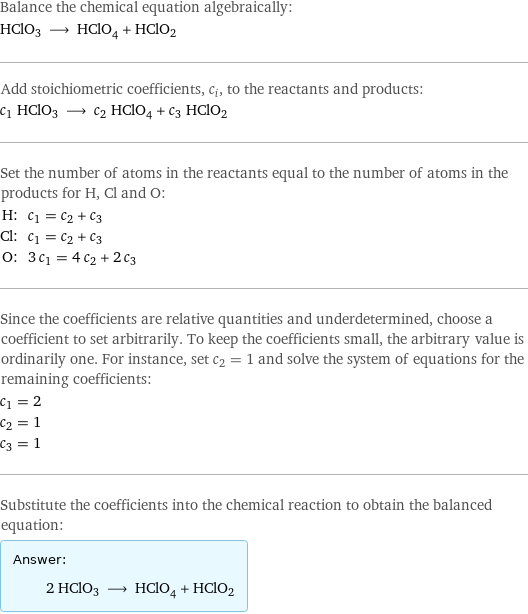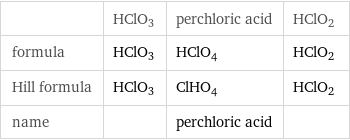Input interpretation

HClO3 ⟶ HClO_4 perchloric acid + HClO2
Balanced equation

Balance the chemical equation algebraically: HClO3 ⟶ HClO_4 + HClO2 Add stoichiometric coefficients, c_i, to the reactants and products: c_1 HClO3 ⟶ c_2 HClO_4 + c_3 HClO2 Set the number of atoms in the reactants equal to the number of atoms in the products for H, Cl and O: H: | c_1 = c_2 + c_3 Cl: | c_1 = c_2 + c_3 O: | 3 c_1 = 4 c_2 + 2 c_3 Since the coefficients are relative quantities and underdetermined, choose a coefficient to set arbitrarily. To keep the coefficients small, the arbitrary value is ordinarily one. For instance, set c_2 = 1 and solve the system of equations for the remaining coefficients: c_1 = 2 c_2 = 1 c_3 = 1 Substitute the coefficients into the chemical reaction to obtain the balanced equation: Answer: | | 2 HClO3 ⟶ HClO_4 + HClO2
Structures

HClO3 ⟶ + HClO2
Names

HClO3 ⟶ perchloric acid + HClO2
Equilibrium constant
![Construct the equilibrium constant, K, expression for: HClO3 ⟶ HClO_4 + HClO2 Plan: • Balance the chemical equation. • Determine the stoichiometric numbers. • Assemble the activity expression for each chemical species. • Use the activity expressions to build the equilibrium constant expression. Write the balanced chemical equation: 2 HClO3 ⟶ HClO_4 + HClO2 Assign stoichiometric numbers, ν_i, using the stoichiometric coefficients, c_i, from the balanced chemical equation in the following manner: ν_i = -c_i for reactants and ν_i = c_i for products: chemical species | c_i | ν_i HClO3 | 2 | -2 HClO_4 | 1 | 1 HClO2 | 1 | 1 Assemble the activity expressions accounting for the state of matter and ν_i: chemical species | c_i | ν_i | activity expression HClO3 | 2 | -2 | ([HClO3])^(-2) HClO_4 | 1 | 1 | [HClO4] HClO2 | 1 | 1 | [HClO2] The equilibrium constant symbol in the concentration basis is: K_c Mulitply the activity expressions to arrive at the K_c expression: Answer: | | K_c = ([HClO3])^(-2) [HClO4] [HClO2] = ([HClO4] [HClO2])/([HClO3])^2](../image_source/75afbbcdda1faa8e08d26654497cc7d6.png)
Construct the equilibrium constant, K, expression for: HClO3 ⟶ HClO_4 + HClO2 Plan: • Balance the chemical equation. • Determine the stoichiometric numbers. • Assemble the activity expression for each chemical species. • Use the activity expressions to build the equilibrium constant expression. Write the balanced chemical equation: 2 HClO3 ⟶ HClO_4 + HClO2 Assign stoichiometric numbers, ν_i, using the stoichiometric coefficients, c_i, from the balanced chemical equation in the following manner: ν_i = -c_i for reactants and ν_i = c_i for products: chemical species | c_i | ν_i HClO3 | 2 | -2 HClO_4 | 1 | 1 HClO2 | 1 | 1 Assemble the activity expressions accounting for the state of matter and ν_i: chemical species | c_i | ν_i | activity expression HClO3 | 2 | -2 | ([HClO3])^(-2) HClO_4 | 1 | 1 | [HClO4] HClO2 | 1 | 1 | [HClO2] The equilibrium constant symbol in the concentration basis is: K_c Mulitply the activity expressions to arrive at the K_c expression: Answer: | | K_c = ([HClO3])^(-2) [HClO4] [HClO2] = ([HClO4] [HClO2])/([HClO3])^2
Rate of reaction
![Construct the rate of reaction expression for: HClO3 ⟶ HClO_4 + HClO2 Plan: • Balance the chemical equation. • Determine the stoichiometric numbers. • Assemble the rate term for each chemical species. • Write the rate of reaction expression. Write the balanced chemical equation: 2 HClO3 ⟶ HClO_4 + HClO2 Assign stoichiometric numbers, ν_i, using the stoichiometric coefficients, c_i, from the balanced chemical equation in the following manner: ν_i = -c_i for reactants and ν_i = c_i for products: chemical species | c_i | ν_i HClO3 | 2 | -2 HClO_4 | 1 | 1 HClO2 | 1 | 1 The rate term for each chemical species, B_i, is 1/ν_i(Δ[B_i])/(Δt) where [B_i] is the amount concentration and t is time: chemical species | c_i | ν_i | rate term HClO3 | 2 | -2 | -1/2 (Δ[HClO3])/(Δt) HClO_4 | 1 | 1 | (Δ[HClO4])/(Δt) HClO2 | 1 | 1 | (Δ[HClO2])/(Δt) (for infinitesimal rate of change, replace Δ with d) Set the rate terms equal to each other to arrive at the rate expression: Answer: | | rate = -1/2 (Δ[HClO3])/(Δt) = (Δ[HClO4])/(Δt) = (Δ[HClO2])/(Δt) (assuming constant volume and no accumulation of intermediates or side products)](../image_source/bdacaa3b02b4e31d071d45e480879fc2.png)
Construct the rate of reaction expression for: HClO3 ⟶ HClO_4 + HClO2 Plan: • Balance the chemical equation. • Determine the stoichiometric numbers. • Assemble the rate term for each chemical species. • Write the rate of reaction expression. Write the balanced chemical equation: 2 HClO3 ⟶ HClO_4 + HClO2 Assign stoichiometric numbers, ν_i, using the stoichiometric coefficients, c_i, from the balanced chemical equation in the following manner: ν_i = -c_i for reactants and ν_i = c_i for products: chemical species | c_i | ν_i HClO3 | 2 | -2 HClO_4 | 1 | 1 HClO2 | 1 | 1 The rate term for each chemical species, B_i, is 1/ν_i(Δ[B_i])/(Δt) where [B_i] is the amount concentration and t is time: chemical species | c_i | ν_i | rate term HClO3 | 2 | -2 | -1/2 (Δ[HClO3])/(Δt) HClO_4 | 1 | 1 | (Δ[HClO4])/(Δt) HClO2 | 1 | 1 | (Δ[HClO2])/(Δt) (for infinitesimal rate of change, replace Δ with d) Set the rate terms equal to each other to arrive at the rate expression: Answer: | | rate = -1/2 (Δ[HClO3])/(Δt) = (Δ[HClO4])/(Δt) = (Δ[HClO2])/(Δt) (assuming constant volume and no accumulation of intermediates or side products)
Chemical names and formulas

| HClO3 | perchloric acid | HClO2 formula | HClO3 | HClO_4 | HClO2 Hill formula | HClO3 | ClHO_4 | HClO2 name | | perchloric acid |
Substance properties

| HClO3 | perchloric acid | HClO2 molar mass | 84.45 g/mol | 100.5 g/mol | 68.46 g/mol phase | | liquid (at STP) | melting point | | -112 °C | boiling point | | 90 °C | density | | 1.77 g/cm^3 | solubility in water | | very soluble | dynamic viscosity | | 8×10^-4 Pa s (at 25 °C) | odor | | odorless |
Units
